Results 1 to 15 of 45
-
19th August 2021, 01:11 PM #1
 Senior Member
Senior Member











- Join Date
- Aug 2021
- Location
- Top End
- Age
- 48
- Posts
- 132
 HARD AND HEAVY Hardwood - WHAT IS IT???
HARD AND HEAVY Hardwood - WHAT IS IT???
This log was found burnt down and exposed to the elements on a mates block for over 9 years. The log is about 180mm in diameter and was about 5" long before being cut up. Likely that the outer layers have been burnt or weathered back.
This is not all the wood from the log but a good representation. I've had it in the shed for the past 6 months and just recently went through a marathon effort to turn it.
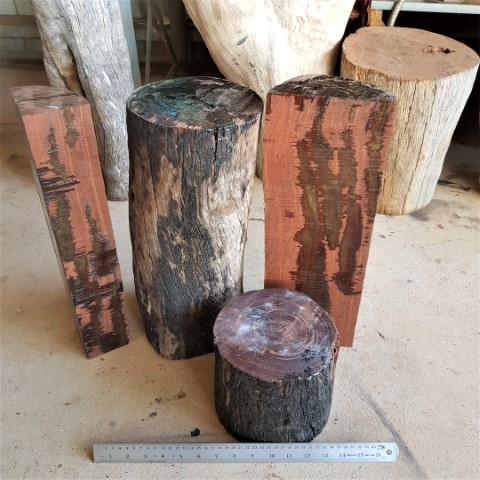
Location: WA/NT region. The soil is rather loamy and close to being black soil. The are many young paperbark trees, some bauhinia, some white gum and iron wood trees on the block. All these trees are young - nothing much more than 30-40 years - it would appear that fires have taken out the mature trees.
The inner rings have suffered some delamination which I filled with epoxy in order to stabilise and turn. The delaminations were mostly less than 1mm - a couple up to 1.5mm
Density:
The wood has been drying over the entire dry season... has had many cycles of wet/dry
This is a 100mm cube - assuming scaling up to 1000mm cube this makes for 1200kg/m3
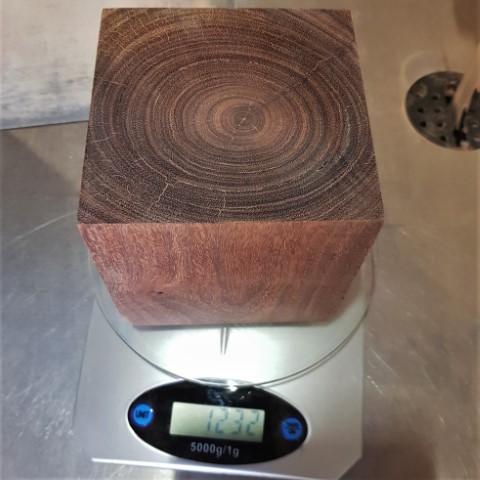
Grain: This wood can be brought to a good lustre without any polishes or products. The below going through 80-2000 grit only
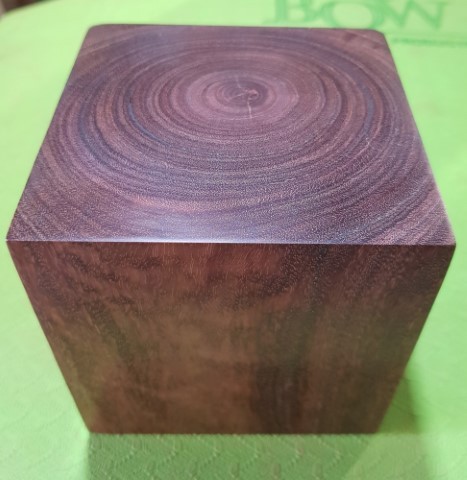
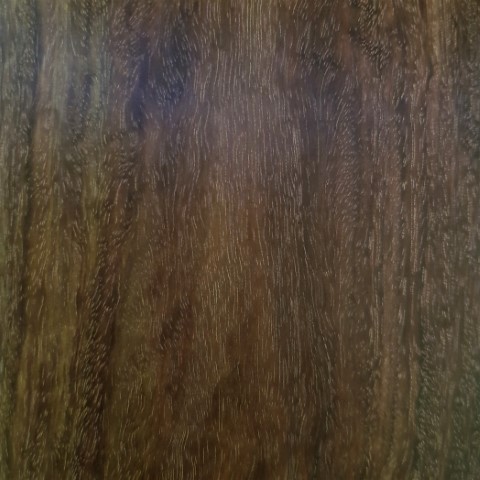
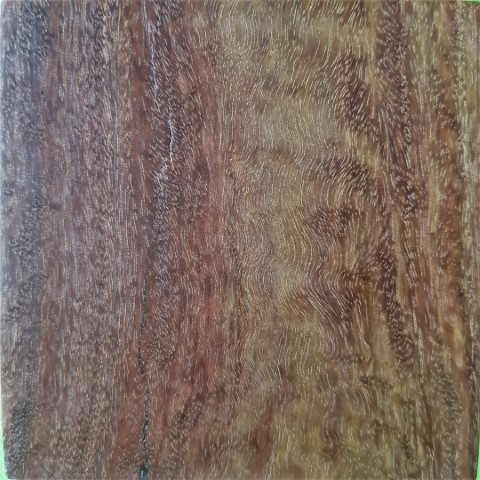
Some golden line streaks can be seen when cut at some angles
There might be some oils in this wood helping the lustre when fine sanding?
The below is a side by side sample of grain comparing to ironwood:
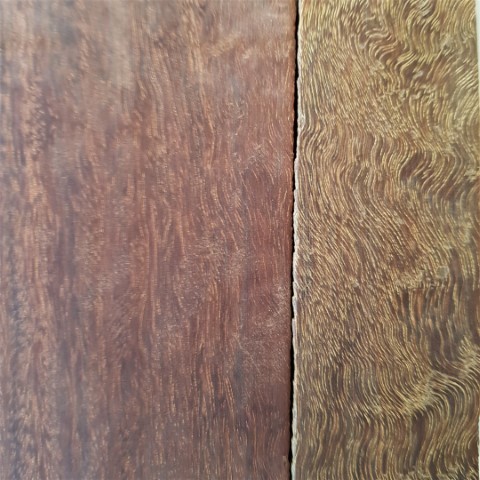
The grain structure and colour is totally different to ironwood
Hardness: I cant test for hardness but when turning a mortar bowl I didnt think I would be able to finish what I started.
Sounds silly but I tried using an arbortech mini carver to see if the carbide would bite in as I turned slowly - it just bounced off barely making a scratch

I lost count how many times I sharpened a good quality gouge but it took 10mm out of my 40-40 completing this + many times sharpening a negative rack carbide finisher.
There were a couple of natural resin pockets that would not fill with epoxy - it wouldn't stick so I had to drill out those small pockets to fill

The lustre on the base is just the wood - no finishing products were used
I showed an old builder from this region who said it looks like Kwilla - but that is only supposed to grow in FNQ?
In my unexperienced opinion it is as beautiful as it is hard to work with. I would love to identify, find a living tree then harvest some seeds to give to my mate to grow.
So - what is this timber? Hoping anyone can help solve this mystery which has my mate and I stumped so far
-
19th August 2021 01:11 PM # ADSGoogle Adsense Advertisement
- Join Date
- Always
- Location
- Advertising world
- Age
- 2010
- Posts
- Many
-
20th August 2021, 08:31 AM #2
 Senior Member
Senior Member











- Join Date
- Jan 2006
- Location
- United States Of America
- Posts
- 194

The tool I purchased has a carbide cutter for turning really hard woods.
I'm not sure and just guessing. It might be blood wood or iron wood.
Not sure where the wood supply stores here in the USA get their exotic hardwood lumber.
-
20th August 2021, 08:50 AM #3

Fallen Woodwork
Very difficult to say and I am not familiar with your region. However, as you have said Ironwood grows in that area I would go with that until somebody comes up with a more precise suggestion. There is a Forum member who goes by the name of "Ironwood," for a very good reason, so you could PM him if he does not see this thread and ask his opinion.
Your bowl looks good.
Regards
PaulLast edited by Bushmiller; 20th August 2021 at 10:17 PM. Reason: Should have addressed the original poster
Bushmiller;
"Power tends to corrupt. Absolute power corrupts, absolutely!"
-
20th August 2021, 01:46 PM #4

I checked the distribution of Erythrophleum chlorostachys & that species certainly occurs in the locality you defined, so I assume that's the "ironwood" you mean? (there several other unrelated species around the wide brown land locally known as "ironwood"). With the proviso that I've had pieces from no more than half a dozen different trees through my hands, I'd reckon your mystery wood fits within the range of what I've seen. Other bits looked more like your known sample piece. Apart from not having a clue as to what else to suggest, I guess what sways me toward ironwood (commonly called "Cooktown" ironwood in Qld) is getting that nice lustre from fine sanding, no eucalypts I've ever struck will polish in the raw like that. Some bits of E. chlorostachys I've had were quite fine-grained like your bit & finished with a similar lustre off 400 grit & a rub-over with 0000 steel wool. This little plane is still in the raw and I reckon the grain & appearance are very close to your bowl wood: Ironwood smthr.jpg
But as Bushmiller says, when you are unfamiliar with a locality & far from home, you don't bet the house on an opinion....

Cheers,IW
-
20th August 2021, 02:07 PM #5

Your density calcs give it away without seeing the images. Look up "cooktown ironwood" - Erythrophleum chlorostachys - which is quite common across the Top End. I have been turning some pens from a small burl that came from near Cooktown.
Ironwood report PDF (agriculture.gov.au) jump to page 108 for some details on regrowth copicing and its apparent "communal" growth.Last edited by Mobyturns; 20th August 2021 at 02:11 PM. Reason: fixed link to PDF.
Mobyturns
In An Instant Your Life CanChange Forever
-
20th August 2021, 02:14 PM #6

As a side comment it will probably become another timber we Aussies will not have access to nor afford if plans to commercialize it and others as high end "craft timbers" eventuate.
Mobyturns
In An Instant Your Life CanChange Forever
-
20th August 2021, 09:53 PM #7
 Senior Member
Senior Member











- Join Date
- Aug 2021
- Location
- Top End
- Age
- 48
- Posts
- 132

Thanks for all the replies gents.
Yes, we have Cooktown Ironwoods here. I appreciate that many other species a colloquially called iron wood trees. There are Iron bark trees here too but I'm getting a little off track. I had all but totally excluded iron wood as a possibility and erred whether I should have mentioned ironwood so as not to introduce bias.
Heres why it could be Erythrophleum Chlorostachys
- Its around 1200kg/m3 As Moby indicates this is in the right ball park
- As Ian says - a good luster can be created from fine sanding
- There are other Iron wood trees on the block
Heres why I think it could be something else:
- It is a totally different colour to many large samples I have (noting it comes from different area and different soil conditions)
- The grain structure from the 6th picture above side by side comparison is totally different (note the timber on the right is from a much older tree and had been cut within 12 months of it dying. It is still moist)
- It just turns differently to other iron wood I have worked on (granted I am green/unexperienced and havnt turned a lot)
- All other pieces of ironwood I have found have suffered termite damage in the inner heartwood/pith (I only take fallen or dead wood)
This is a large branch from a tree that died last year. Much lighter in colour and severely damaged from white ants
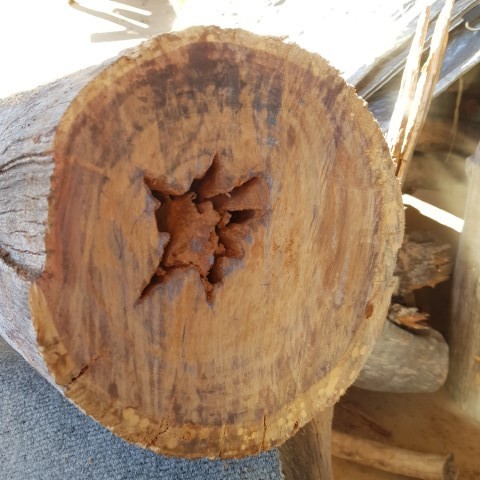
Some questions which might help explain why a numpty might think these are two different species:
Would a burnt stump protect the pith from termite damage? I can imagine termites turning noses up at charcoal.
Does colour variation commonly occur to this degree?
Does age and moisture content of the wood change its colour? - I think I read somewhere that ironwood may darken when cut
Perhaps the aged timber looks and turns differently from all the seasonal cycling
Thanks again for all your time, help, experience and kind words
-
20th August 2021, 09:56 PM #8
 Senior Member
Senior Member











- Join Date
- Aug 2021
- Location
- Top End
- Age
- 48
- Posts
- 132

Thanks Woodhog. I think I need to buy several more carbide cutters/hollowers and finishers
-
20th August 2021, 10:00 PM #9
 Senior Member
Senior Member











- Join Date
- Aug 2021
- Location
- Top End
- Age
- 48
- Posts
- 132

Thanks Paul.
I will get in touch with that member. Looking at the replies I have received which concur with your opinion I am convinced it is Ironwood.
Perhaps a better way for me to look at it is to try to prove its not
-
20th August 2021, 10:04 PM #10
 Senior Member
Senior Member











- Join Date
- Aug 2021
- Location
- Top End
- Age
- 48
- Posts
- 132

Thanks Ian - yes that plane does look very similar.
Great looking block of wood - thanks for the pic
-
20th August 2021, 10:08 PM #11
 Senior Member
Senior Member











- Join Date
- Aug 2021
- Location
- Top End
- Age
- 48
- Posts
- 132

Thanks Moby.
I had found that pdf just a couple weeks ago when trying to identify this log.
My trouble was probably the limited samples of ironwood I had before to go on - hadnt seen such a great looking timber before. Especially a piece with this providence.
Yes - sadly these trees are getting fewer in number. The regularity and intensity of the fires do not allow the saplings to reach maturity
-
21st August 2021, 07:28 AM #12

Sadly the intensity and frequency of fires and pressure from grazing is having detrimental impacts upon recruitment of many native species. I have seen quite a bit of sawn CKI and cut survey reference shields in a few and have found the grain & coloration to be very similar to your samples above. That pdf has species lists of tree species in those typical woodland communities so it will allow you to work through potential candidates.
As for using termite damage as an indicator, I personally haven't seen any termite damage to any CKI, and doubt that your termite affected pieces are CKI. There is other research papers about examining lyctine damage to top end timbers which list several timbers being assessed for commercial harvest, Darwin Stringybark, etc. They also have relatively high densities but not typically comparable to CKI. John Goyne knows all about milling Darwin Stringybark.
Darwin Stringybark - "Density can range between 990 to 1200 kgm3 with the timber sourced from North Queensland having the highest average density with an average of 1170kgm3. "
Powerderpost & I joke that you can always tell if its CKI, 'cause the termites all have dentures. Though Darwin Stringybark is also noted for its termite resistance.
Though Darwin Stringybark is also noted for its termite resistance.
"It is renowned as a source of timber that can withstand termite attack, an important characteristic in the Top End of Australia where termites can ravage timber structures."Mobyturns
In An Instant Your Life CanChange Forever
-
21st August 2021, 11:22 AM #13
 Senior Member
Senior Member











- Join Date
- Jul 2008
- Location
- geelong
- Posts
- 359
 ??
??
Probably something else but reminds me of something that was called dead finish. very similar look and characteristics

-
21st August 2021, 02:13 PM #14

"Dead finish" is another of those common names applied to at least 4 quite different species that I know of. One, Archidendropsis basaltica is a very hard dry-country wood, up there for density. Like all woods, its appearance is sufficiently variable that some bits could look like the subject wood. I've had about 4 different lots & no two were the same, one you would swear is a different species, but it was reliably identified & came from the right spot (it was gorgeous stuff too, but one of the most difficult bits of wood I've ever worked with!):
Gauges_Dead Finish.jpg DF2.jpg DF cutting g.jpg
I gave it brief consideration but dropped the idea when I looked up its distribution, it appears to be entirely within Qld, so unless someone carried a pocketful of seeds a long, long way, I think that one can be safely ruled out.
Identifying a piece of wood accurately from a picture (or even in the hand) can sometimes be next to impossible. The reason the same common name is applied to so many unrelated woods tells you one good reason why! If the wood has a characteristic odour when sawn, or some other unique property, it can be easy to say with confidence what you've got, but none of the Erythrophleum I've worked with had anything I'd call a characteristic odour, unless I've forgotten (not impossible ). It is, however, a fairly potent sensitiser, so I'll say to the OP, if your eyes water & you start sneezing violently next time you have a crack at it, that'll be a good indication you're on the right track.....
). It is, however, a fairly potent sensitiser, so I'll say to the OP, if your eyes water & you start sneezing violently next time you have a crack at it, that'll be a good indication you're on the right track..... 
Cheers,IW
-
21st August 2021, 04:37 PM #15
 Senior Member
Senior Member











- Join Date
- Aug 2021
- Location
- Top End
- Age
- 48
- Posts
- 132

Thanks again Moby.
I totally agree about the fires and pastoral impacts. Old practices and mindsets that may (or may not) have been fine 30 years ago are creating a monoculture of plant and animal life.
The tree I am am comparing to with the termite damage certainly looks like ironwood.
I took some photos of it at the beginning of the year that should help determine if this is ironwood
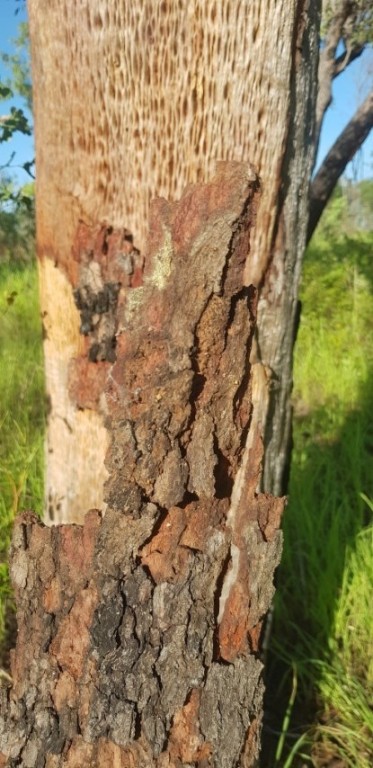
This was in January when the bark had nearly completely fallen off.
The back of the bark had very sharp horns
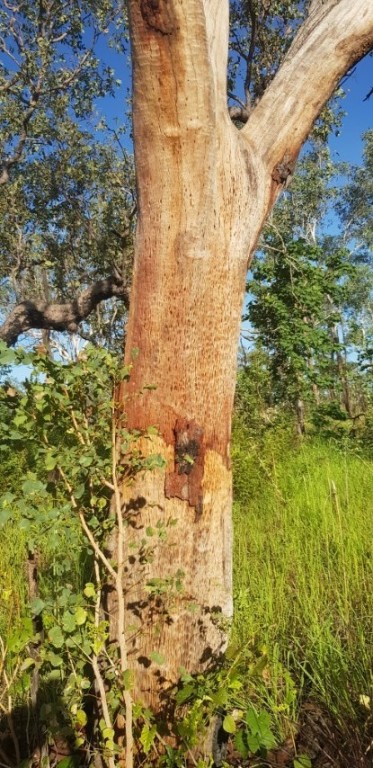
The sapling in front has sprouted no more than 0.5m away from the trunk. Likely lignotuber?
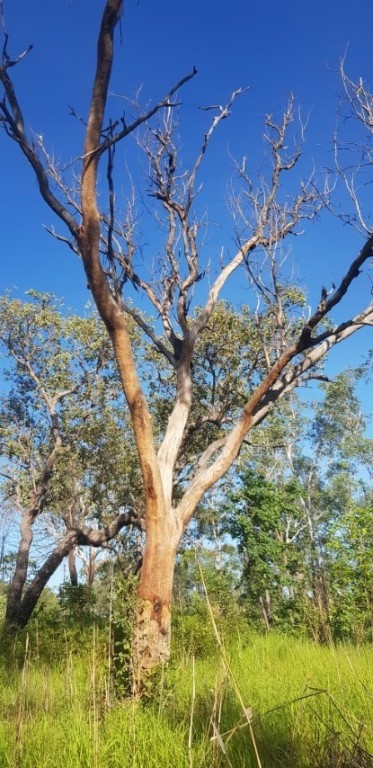
From a distance

Pics from here on have been taken today - it has become significantly grey

Deep eliptical sockets left from the barks sharp horn anchors
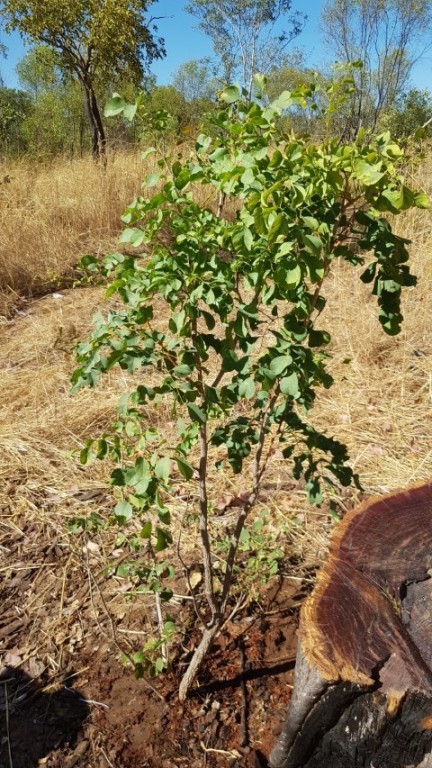
Possible ligno tuber today
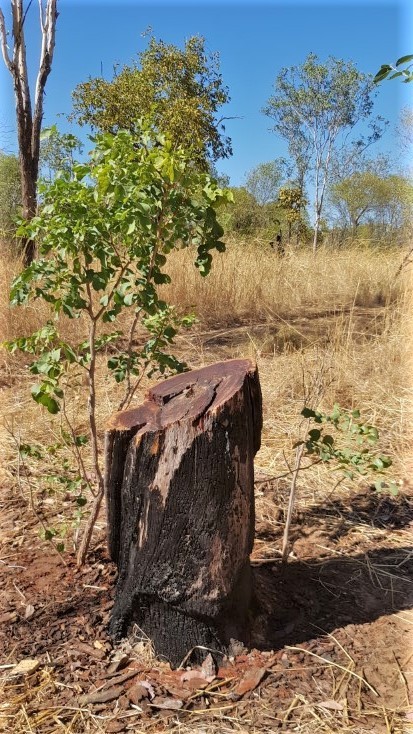
A little difficult to see but there is a small shoot of green growth from the base of the trunk just over half way up on the right. This appeared about 3 months ago. There is a dead lignotuber on the right also

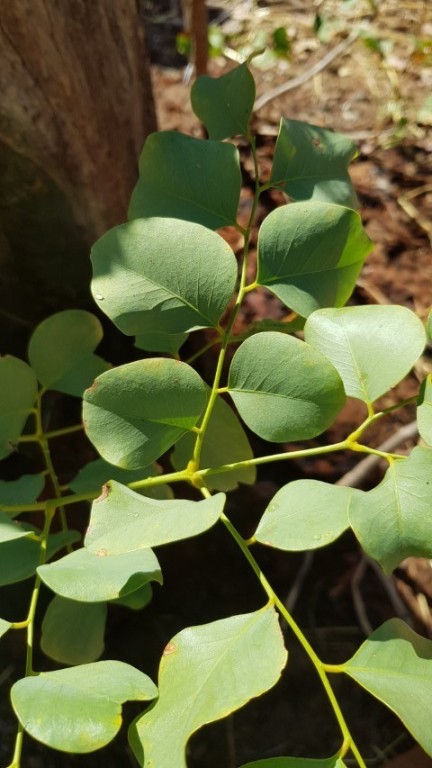
Close of of new shoot leaves
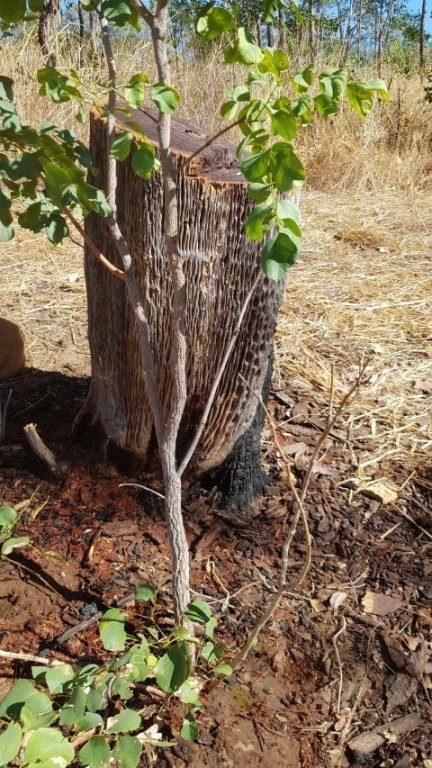
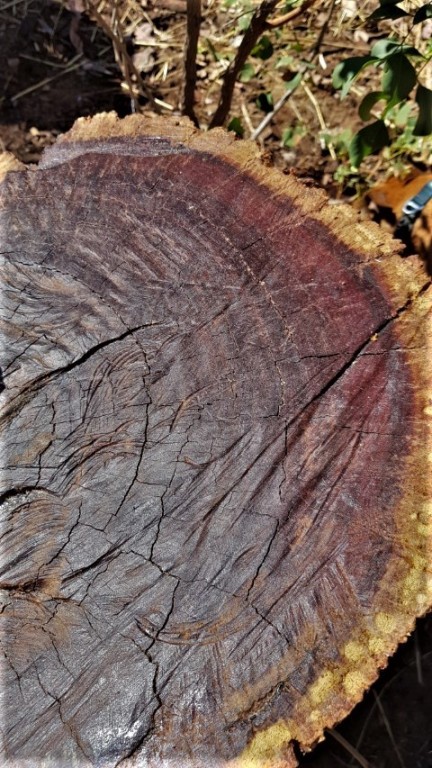
Stump - Excuse the horrible looking cuts - done with a 350mm bar electric chainsaw
Trunk is 500mm+
This tree started suffering after a crown fire went through a few years ago. We have never had a crown fore before. Ground fuel is always the cause of fires in this region so normally trees of this size get a bit burnt at the base but the canopy is fine.
Not so with a devastating fire with fierce winds that saw trees burning from the top down. Many trees lost all canopy but even with trunks totally intact they died. This was a truly fierce fire that had not been seen in this region before.
Is it possible that the stress from the fire left it susceptible to insect attack?
Similar Threads
-
Hi there trying to identify this timber( heavy, hard to cut,)
By Satchmo in forum TIMBER SPECIES GUIDESReplies: 1Last Post: 27th April 2021, 10:19 PM -
milled mountain ash and something very dense and heavy and hard
By fubar in forum SMALL TIMBER MILLINGReplies: 4Last Post: 25th February 2017, 05:18 PM -
How hard is hard enough for a hardwood floor?
By Robd in forum TIMBERReplies: 7Last Post: 30th January 2012, 06:37 PM -
Timber ID Hard as hell and Heavy as lead
By woodworm1 in forum TIMBERReplies: 7Last Post: 18th July 2010, 11:01 PM -
Hard as hell Aussie hardwood!
By Driver in forum WOODWORK - GENERALReplies: 16Last Post: 25th February 2006, 10:49 PM



 Thanks:
Thanks:  Likes:
Likes:  Needs Pictures:
Needs Pictures:  Picture(s) thanks:
Picture(s) thanks: 
 Reply With Quote
Reply With Quote
